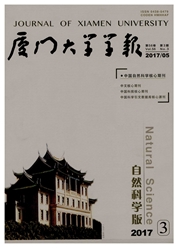

 中文摘要:
中文摘要:
微型生物是海洋生态系统中"看不见的主角",在资源环境以及全球变化中扮演着举足轻重的角色.本研究通过方法创新和大量现场调查,从一类特殊微型生物类群——好氧不产氧光合异养细菌(AAPB)入手,展开了微型生物生态过程与机制的系统研究,修正了国际同行AAPB计数方法的误差,获得了全球海洋AAPB的分布规律,解释了以往现场实测结果的分歧,澄清了以往理论上的偏颇认识;建立了包括不产氧光能利用途径的上层海洋碳循环模型,并通过大量现场实测揭示:细菌光能利用关系到海区碳循环的"源""汇"格局;在这些研究基础上探讨了新的海洋碳循环机制,提出了"微型生物碳泵"理论框架,为全面认识海洋储碳机制、促进学科交叉、研发海洋碳汇奠定了基础.
 英文摘要:
英文摘要:
The ubiquitous picoplankton are major components of food webs and thus they play key roles in biogeochemical cycle and energy flow in the marine ecosystem.Thereinto,aerobic anoxygenic phototrophic bacteria(AAPB) is an important functional group with capability of harvesting light energy,and has a particular role in the ocean′s carbon cycling.By application of new methods and further innovation of related techniques,and through extensive field investigations in the Chinese coastal wasters and the three Oceans,great data sets have been set up and systemic results have been obtained on microbial processes in the ocean′s carbon and energy flows.The following are the major achievements.1) We established a new protocol as "time series observation based infrared epifluorescence microscopy"(TIREM) which enabled us to enumerate AAPB accurately;2) And consequently revealed the wide distribution and unexpected abundance of AAPB in coastal waters(more abundant than in oligotrophic oceanic water which was thought to be the major niche of AAPB);3) Based on the above data sets,a novel model is proposed,where bacteriochlorophyll a induced anoxygenic phototrophy and a proteiorhodopsin based proton pump are included;4) Furthermore for carbon sequestration below the surface ocean,a conceptual model of microbial carbon pump(MCP) is proposed,which is in contrast to the well known sinking flux-based biological pump.Overall,these achievements have filled several research banks in China,and lead in the international field of marine microbial ecology.
 同期刊论文项目
同期刊论文项目
 同项目期刊论文
同项目期刊论文
 Environmental control of growth and BChl a expression in an aerobic anoxygenic phototrophic bacteriu
Environmental control of growth and BChl a expression in an aerobic anoxygenic phototrophic bacteriu Comparative study of picoplankton biomass and community structure in different provinces from subarc
Comparative study of picoplankton biomass and community structure in different provinces from subarc Different Planctomycetes diversity patterns in latitudinal surface seawater of the open sea and in s
Different Planctomycetes diversity patterns in latitudinal surface seawater of the open sea and in s Characterization of cytophaga-flavobacteria community structure in the bering sea by cluster-specifi
Characterization of cytophaga-flavobacteria community structure in the bering sea by cluster-specifi Microbial production of recalcitrant dissolved organic matter: long-term carbon storage in the globa
Microbial production of recalcitrant dissolved organic matter: long-term carbon storage in the globa Mamefiella alba gen. nov., sp nov., a marine bacterium of the Roseobacter clade in the order Rhodoba
Mamefiella alba gen. nov., sp nov., a marine bacterium of the Roseobacter clade in the order Rhodoba Coexistence of Two Different Photosynthetic Operons in Citromicrobium bathyomarinum JL354 As Reveale
Coexistence of Two Different Photosynthetic Operons in Citromicrobium bathyomarinum JL354 As Reveale Stakelama pacifica gen. nov., sp. nov., a novel member of the family Sphingomonadaceae isolated from
Stakelama pacifica gen. nov., sp. nov., a novel member of the family Sphingomonadaceae isolated from Profiling Planctomycetales diversity with reference to anammox-related bacteria in a South China Sea
Profiling Planctomycetales diversity with reference to anammox-related bacteria in a South China Sea Distinct distribution pattern of abundance and diversity of aerobic anoxygenic phototrophic bacteria
Distinct distribution pattern of abundance and diversity of aerobic anoxygenic phototrophic bacteria Source environment feature related phylogenetic distribution pattern of anoxygenic photosynthetic ba
Source environment feature related phylogenetic distribution pattern of anoxygenic photosynthetic ba 期刊信息
期刊信息
